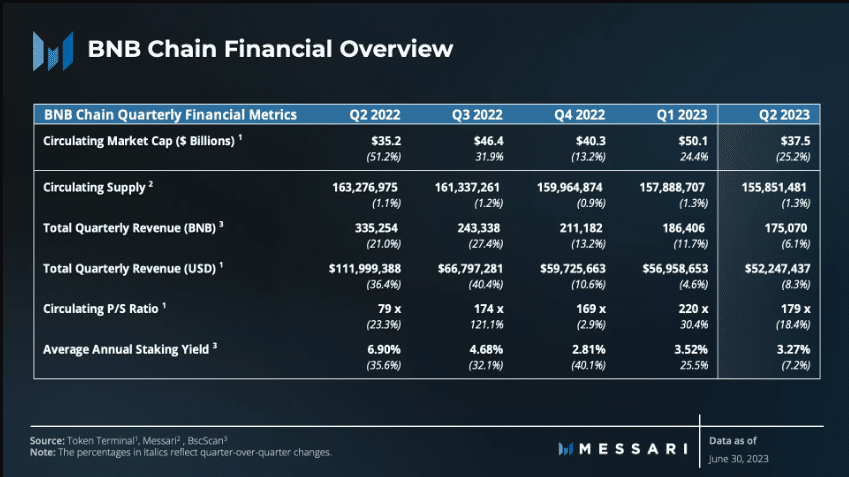Altcoin
BNB Chain’s Q2 was disappointing, but will Q3 be different?
The distributed blockchain network accomplished certain advancements in the quarter. But the SEC hammer appeared and plunged some areas of the ecosystem.

- BNB faced regulatory persecution, leading to a fall in its revenue and coin value.
- The blockchain has implemented some upgrades and plans on expanding its validator model.
BNB Chain, the native blockchain of the Binance [BNB] ecosystem, encountered some financial anguish during the second quarter of the year. According to the latest insight by Messari, BNB Chain’s total revenue decreased by 6.1% on a Quarter-on-Quarter (QoQ) basis.
Realistic or not, here’s BNB’s market cap in OP’s terms
Fees and the SEC fail to help revenue
According to the report, one reason for the fall in BNB Chain revenue is the decrease in transaction fees. Usually, when there is a rise in user activity on the chain, transaction fees increase.
In turn, it helps revenue. But Messari noted that transaction fees fell by 25.5% and network value decreased by 25.2%.
Beyond facing financial challenges, BNB (the coin, not the chain) was also affected by some regulatory decisions.
In June, the U.S. SEC accused the country’s arm of its parent company, Binance, of having engaged in selling unregistered investment contracts, which included the coin. This resulted in a decrease in the BNB price alongside other assets, leading Messari to note that,
“The SEC complaint in June coincided with downward pressure on the value of BNB, which declined 25.2%. In contrast, the total crypto market cap increased by 2% QoQ, which was primarily driven by BTC and ETH, rising 7% and 6%, respectively.”
Staking perseveres, developments heighten
However, the second quarter was not one where the BNB Chain registered a widespread decline. In the same quarter, staking remained stable on the network. For context, BNB holders can stake their tokens and receive a portion of the transaction fees while acting as validators.
Interestingly, stability was driven by the introduction of BEP-131,153 and BEP-159. All of these Binance Smart Chains Evolution Proposals were involved in producing a native staking protocol onto the BNB Chain.
As a result, it made it easier to facilitate staking distribution and participation.
In terms of development activity, BNB Chain had a ton of upgrades to look back at. Between April and June alone, the Planck hard fork, designed to implement security between the Beacon Chain and BNB Chain, happened.
Other developments include the Luban hard fork and opBNB integration. The Luban hard fork helped in integrating the BEP-126, 174, and 221 to make the network more secure and faster to use.
On the other hand, the BNB Chain introduced the OpBNB to help with scalability on the network. Designed based on Optimism’s [OP] Stack, the OpBNB is the BNB Chain’s L2 solution to enable data caching, optimization, and block mining.
Look! Participation is building up
Following these developments, transactions on the BNB Chain increased. The daily active addresses also increased by 25.6% from the previous quarter. Daily active addresses are a good indicator of successful transactions over a particular blockchain.
So, the spike in the metric implies that sending and receiving of assets via the BNB chain was very present throughout the quarter. Messari explained,
“BNB Chain’s daily average active addresses reached ~1.4 million and increased by 25.6% QoQ. The metric nearly reached the all-time average of ~1.5 million reached at the end of the last bull cycle in Q4 2021. Average new unique addresses increased 91.1% QoQ and reached all-time highs after a spike in activity in late April.”
But blockchain transparency also mentioned that the surge in active addresses would have been impossible without LayerZero.
Although still in its Testnet stage, LayerZero is a project developed by Stargate. As an omnichain interoperability protocol, LayerZero enables cross-chain applications to communicate with one another.
In addition, it also acts as a connective layer to ensure the prevention of liquidity exploits through decentralized bridges. So, LayerZero contributed to BNB Chain’s active addresses since it hosted around 250,000 LayerZero and Stargate daily transactions.
NFTs recover, GameFi opts out, but…
With respect to NFTS, BNB Chain initially registered a decline in Q1. However, buying and selling of collections linked to the blockchain picked up in Q2. Unique buyers increased by a whopping 289.3%.
This led to an increase in activity, such that secondary sales of the NFTs increased by 233.2%. However, it was not the same circumstance as the GameFi arm of the chain.
According to Messari, GameFi activity slowed down by 3%. But more games have emerged on the chain, which has resulted in a rise in Unique Active Wallets (UAW).
As per the Total Value Locked (TVL), BNB Chain fell by 26.3% in the quarter. The TVL measures unique deposits into decentralized Applications (dApps) under a chain.
One cogent reason the chain was affected was the fall in liquidity provided by liquid staking protocol Ankr from $70 million to $50 million. However, BNB Chain was able to make up for this decrease as DEX volume increased, thanks to the likes of PancakeSwap [CAKE].
Read Binance Coin’s [BNB] Price Prediction 2023-2024
In conclusion, BNB Chain may have experienced a dip in finance. But the increases registered proved that the chain remains a healthy one. Going forward, the chain plans to integrate a Zero Knowledge (ZK) rollup zkBNB alongside the opBNB.
Another reason that it could have a better Q3 is its plans to create a new validator model. While the date for this plan is still unconfirmed, BNB could increase its balancing mining participants from 29 validators to 100.


